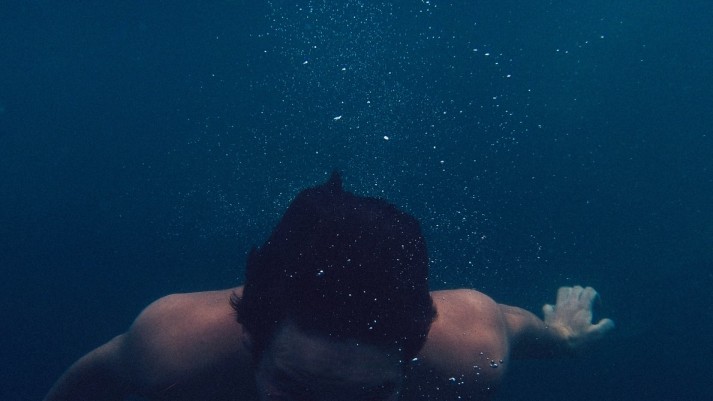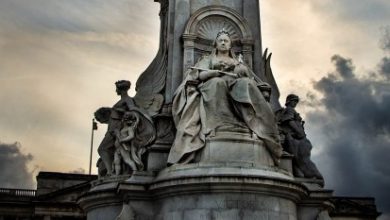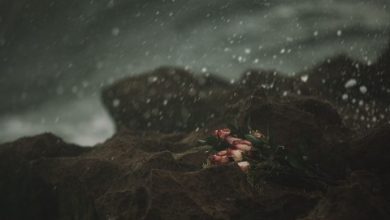
Haruki Murakami wrote the short story “The Seventh Man” in 1996, drawing his inspiration from a dream while engaged in surfing. Its preoccupation lies with the consequences of childhood trauma in an adult’s life with its set of challenges. Thrusting on the power of nature and its sublime effect on the narrator, the author delivers a compelling narrative that advises its readers to put up a fight against their fears and escape its inscrutable web.
The Seventh Man | Summary
The story opens with a frame narrative that introduces the character of the seventh man who is narrating a story from his past comprising of an encounter with nature’s power in the form of a typhoon which Japan as an island country often experiences. The past then transforms the man into the narrator who recalls losing his best friend K to a huge sea wave when he fails to hear the narrator’s warning. Witnessing his friend being swallowed by the sea, the narrator falls unconscious and views K resting at the tip of a wave attempting to grab him and take him to another world. This fear elongates, gradually translating into trauma and compelling the narrator to leave his hometown. After forty years, he revisits the shore where he saw K for the last time, and unable to bear the pain, he resorts to finding solace in K’s seascape paintings which he has gifted to the narrator. Surprisingly, they help him to re-establish his relationship with nature, especially the sea. The narrator is able to overcome his fear with his eventual realization that his nightmares are not K’s anguish at his friend’s failure to protect him but rather a departing smile. Confronting is what releases the narrator from the chains of horrifying memories and enables him to move forward in his life to live the remaining years in peace and tranquillity.
The Seventh Man | Analysis
Murakami pens down a frame narrative where the introductory story sets the stage for the titular character’s journey into the past concerned with his battle against nature and trauma through a third-person limited narrator. The second narrative is the protagonist’s i.e. the seventh man’s first-person account of his encounter with a typhoon at the age of ten where strong winds and high sea waves were an unbelievable spectacle. Imagery and figurative language to compare nature and its elements to domesticity is a unique strategy that the author employs to facilitate a smooth understanding of the psychological and emotional complexities. Gloominess in mood and regretful in tone, Murakami artistically sets an apt eerie atmosphere for the seventh man to narrate his story to his group with winds rattling the windows of the room in the background.
The story deals with how and in what shape one perceives the forces of nature. For the narrator, “it was a wave” which symbolizes an agent of death. The approaching sea waves at the shore leave the narrator in a train of contemplation which the caesuras reflect in his overwhelming response. He couldn’t fathom the phenomenon: “And then, just as soundlessly, the water drew back—and stayed back. The waves that had approached me were as unthreatening as waves can be—a gentle washing of the sandy beach. But something ominous about them—something like the touch of a reptile’s skin—had sent a chill down my spine. My fear was totally groundless—and totally real. I knew instinctively that they were alive.” Death pays a visit to the narrator but instead of embracing him, it seizes his friend K. Adding to the burden of guilt is the lack of recognition K’s parents extend to the narrator’s presence or fault in the missing of their child.
While flashbacks enable the readers to have a peak into the past of the narrator, foreboding assists in anticipating and predicting future events, in this case when the narrator utters “I knew that the wave was coming, and K. didn’t know.” K’s lack of knowledge about the impending calamity makes him vulnerable to the impenetrable depths of the sea. The play of time operates in the town too where the narrator spends his young years. When he revisits it, it transforms into an industrial setup with only the seascape still the way it was. This signifies that it is only nature that stands against the ravages of time. It is due to this that the narrator is able to reconcile with the sea.
When the narrator ends his narration, the listeners are silently speculating the intensity of the events. The inarticulateness of trauma and conquering it thereafter is the crux of the story. The narrator i.e. the seventh man ends his tale with a lesson: “…the only thing we have to fear is fear itself…which comes to us in many different forms, at different times, and overwhelms us. But the most frightening thing we can do at such times is to turn our backs on it, to close our eyes. For then we take the most precious thing inside us and surrender it to something else. In my case, that something was the wave.” Never give in to anything that holds the capacity to overpower and torture you. Fear is only in the mind and to face it is the appropriate agential action an individual should work towards.
Acknowledging the title of the story, the author does not provide any identity-specific information and addresses his protagonist only as the seventh man which one can assume to be a number allotted to him in the group with whom he shares his life episodes. By not naming him, the author also extends this experience to all mankind where a human who has faced, is facing, or might face a similar fate can relate to this universal notion of fear and trauma.
The Seventh Man | Literary Devices
Analogy
“Every once in a while, the house would creak and shudder as if a huge hand were shaking it.”
Contrast
The narrator reveals the difference in the generational attitudes towards a natural disaster: “To the adults, typhoons were an annoyance and a threat they had to face almost annually, but to the kids, removed as we were from such practical concerns, it was just a great big circus, a wonderful source of excitement.”
The narrator discloses his reflex during the second shift of the wave which was unlike the previous one: “This time, though, I didn’t run. I stood rooted to the sea wall, entranced, waiting for it to attack. What good would it do to run, I thought, now that K. had been taken? Or perhaps I simply froze, overcome with fear. I can’t be sure what it was that kept me standing there.”
Imagery
“Thick, gray clouds edged across the sky, and patches of blue showed here and there.”
“In the tip of the wave, as if enclosed in some kind of transparent capsule, floated K’s body, reclining on its side.”
“I looked up at the sky. A few gray cotton chunks of cloud hung there, motionless.”
Irony
“I knew that the wave was coming, and K. didn’t know. As clearly as I knew what I ought to be doing, I found myself running the other way—running full speed towards the dyke, alone.”
Metaphor
The strong winds are addressed as “an absolute giant” by the seventh man.
Onomatopoeia
The wind “moved past the house with one final whistle.”
The wind “began to howl”
Personification
The wind “swallowed everything that mattered most to me.”
“The storm’s great “eye” seemed to be up there, fixing its cold stare on all of us below.”
“Without any sound or other warning, the sea had suddenly stretched its long, smooth tongue out to where I stood on the beach.”
“…soft sun of late afternoon embraced everything below…”
Simile
“…the rain began to beat against the house with a weird dry sound, like handfuls of sand.”
The wind will “stay quiet like this for a while, maybe fifteen, twenty minutes, kind of like an intermission.”
“The white sand stretched out before us as far as we could see. The whole, huge space felt like a room without furniture…”
“But something ominous about them [waves]—something like the touch of a reptile’s skin—had sent a chill down my spine.”
“A wave like a huge snake with its head held high, poised to strike, was racing towards the shore.”
“It looked like part of a gigantic rug that had been yanked by someone at the other end of the earth.”
“…another huge wave raised its head to strike. It towered before me, blocking out the sky, like a deadly cliff.”
“From far above my head it began to fall, losing its shape, like a brick wall slowly crumbling.”
The nightmares “would come to me now and then, like debt collectors at the door.”
“Forty long years collapsed like a dilapidated house, mixing old time and new time together in a single swirling mass.”
The Seventh Man | Themes
Contingency, Natural Calamity and its Repercussions
Various countries regularly experience fiery forces of nature in the shape of calamities such as earthquakes, landslides, cyclones, etc. due to their geographical location in proximity to sea or high altitudes. Japan is one of them where natural disasters are a frequent phenomenon. People are well prepared in advance as they track weather forecasts with their remedial kits and plan of action. In the story, the event of the typhoon’s arrival exhibits the before and after picture of the narrator’s town. Strong winds accompanying powerful sea waves sweep everything in its way- human or non-human. The once beautiful seashore fills with the material belongings of people from innumerable places. Such natural calamities also become a traumatic memory if they cause death along with destruction. The narrator’s insufferable post-traumatic stress disorder after K’s death hinders him from living his life in its pleasures. The fear engulfs him and prevents him from being near any river body or flying in an airplane. The story instructs the readers to always be prepared for emergencies as nature is a powerful entity that possesses the capacity to nourish as well as take away life.
Fear
Every living being on earth suffers from one fear which can vary depending on the individual. The claustrophobic nature of fear facilitates suffering through nightmares and unpleasant memories. The seventh man who is also the narrator, lives in a fear of sea waves and strong winds for almost forty years after witnessing the death of his close friend K. As a consequence, he often sweats at night due to evil dreams and thus does not marry if he can’t fathom sharing his worries with a partner who may or may not understand him. However, it is necessary to overcome it and the only way out is to face it and look in the eye of it. The narrator revisits the seashore and reflects on K’s paintings of seascape beauty which gradually enables him to befriend the sea once again. Getting hold of one’s fears is not an overnight process. It requires careful consideration and sensitivity. To live in fear makes one vulnerable and prevents him/her from living life peacefully with all its pleasures and merits. The narrator misses out on his youthful experiences of adventure and exploration and even a blissful married life due to his fears which is a lesson readers can take away.
Friendship
Some ties are thicker and stronger than blood relations. The narrator’s friendship with his neighbor K as children is the fondest and most valuable time the former treasures in his memories. K is like a younger brother whom the narrator protects due to his speech impediment. They share similar tastes and love for the sea. K even understands his friend’s silence and is always ready to accompany him in his ventures. But no such journey on the day of the typhoon writes off his death warrant. The narrator senses the approaching sea waves and fails to warn K. His thoughts do not sync with his actions as instead of saving his friend he runs away in the opposite direction, allowing the sea monster to swallow his friend. K is never reported dead as his body is never found but he always continues to live in the memories. By remembering him even after forty years, the narrator establishes his genuine love for his friend.
Guilt and Trauma
Post-Traumatic Stress Disorder, commonly known as PTSD is a psychological condition that is triggered as an after-effect of a terror-inducing event. The victim is unable to live his/her life without the presence of fear and constant anxiety. The narrator in the story experiences trauma of losing his friend to the typhoon in his childhood which couples with his guilt for a failure to protect him. It rips him off a healthy and happy life and pushes him into the drudgery of loneliness. The guilty conscience begins to manifest K’s presence as nightmarish. But he eventually learns to face his fear and overcome his guilt to render an ineffective stance to his trauma, which every individual should work towards if facing a similar situation.
The Seventh Man | Characters
The Seventh Man – He is the narrator in the second frame of the story whose recollection of a traumatic incident in his past forms the main plot of the story. A typhoon consumes his best friend K when he fails to notice the approaching gigantic waves. Being a protector to K as an elder brother and taking pride in the fact during their childhood, things flip when he chooses his own life over K’s. He spends his entire until his mid-fifties in fear and guilt for not saving his friend over himself. In the present when he narrates his story to a group, there is a scar near his right eye which is probably evidence of his encounter with the overpowering waves. Any identity-specific details are absent from the narrative and he is only addressed as the seventh man in the first frame of the narrative. As the only dynamic character who experiences a change in his personality after the disaster, he is an interesting character who explores the human psyche in its complexity when it comes to decision-making and fighting back some deeply penetrated fears.
K – He is the childhood best friend of the narrator who is a victim of the destructive typhoon that hit their town when they were young. He suffers from a speech impediment and is frail and skinny with a pretty face. Often a subject of ridicule by his peers, the narrator acts as his support system through all tough times but fails to be a protector when the waves consume his friend right in front of him. His strong artistic bent compensates for his poor academic performance. The landscape paintings he gifts to the narrator turn out to be the only medium of solace that reconnects him to the water and brings him back from the world of fear. The narrator imagines his best friend as a grinning young boy lending out his hand to take him to the other side of the world. But in effect, it is all the workings of a traumatic mind that produces K as a vengeful boy punishing his friend for his failure to protect him.




